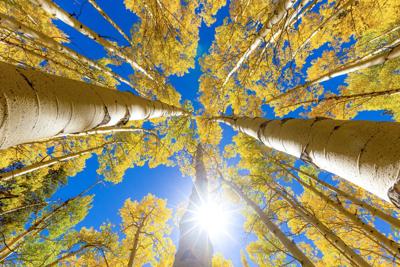It might seem like summer just started, but fall is right around the corner in Colorado and we all know what that means – golden aspens and leaf peepers. While the color change is expected, pinning down exactly when this will happen and how long it will last is a bit trickier.
Fall colors in Colorado typically peak between mid-September and early October, but a number of factors can impact this date range, with leaves showing up as yellow as early as August in some years.
Here's a look at what may impact fall colors this year:
1. Where the trees are located matters.
Aspens found at higher elevations tend to change colors first. Some of those higher elevation areas include mountain towns like Aspen, Breckenridge, Crested Butte, and Telluride. Lower elevation spots include places like Cañon City, Colorado Springs, and Denver. This means that different places will have different peak fall color dates. Be aware of this prior to planning a leaf-peeping trip.
2. Water levels could impact the show.
Something called 'drought stress' can cause leaves to change earlier compared to the norm. While this is unlikely to have an impact in the eastern half of Colorado where drought isn't present, the western half of the state remains quite dry. This means that trees in the western part of the state, or in any area that's particularly dry, could change sooner compared to their norm. See an updated drought map here.
3. Continued warmth could mean better leaf peeping.
Temperature could have an impact on when leaves change and how long golden aspens last. While Colorado has been quite warm as of late, if temperatures gets colder, it could trigger an earlier leaf change – especially if temperatures drop before freezing or if snow falls. It's also worth noting that cold temperatures can cause leaves to brown faster while wind, rain, hail, and snow that comes with changing seasons can knock leaves to the ground.
4. Fungus could be a curveball.
Colorado had a wet spring in several parts of the state and with moisture comes fungus. In some cases, this can spread to the leaves of the tree – one reason why leaves may appear brown or with black spots. This tends to be most seen when a wet spring follows a dry summer. When this does occur, it tends to impact a specific area where moisture has been present. Read more about that here.
In conclusion
Plan for peak leaf-peeping to hit between mid-September and early October, seen in higher elevation areas and drier parts of the state first. It's still a little soon to determine exactly when leaves will start changing, but be on the lookout for news about that in upcoming weeks.
STAY INFORMED: Sign-up for the daily OutThere Colorado newsletter here








(0) comments
Welcome to the discussion.
Log In
Keep it Clean. Please avoid obscene, vulgar, lewd, racist or sexually-oriented language.
PLEASE TURN OFF YOUR CAPS LOCK.
Don't Threaten. Threats of harming another person will not be tolerated.
Be Truthful. Don't knowingly lie about anyone or anything.
Be Nice. No racism, sexism or any sort of -ism that is degrading to another person.
Be Proactive. Use the 'Report' link on each comment to let us know of abusive posts.
Share with Us. We'd love to hear eyewitness accounts, the history behind an article.